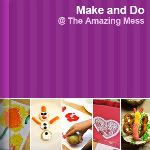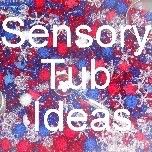When I taught preschool having a sensory table was a must. Sensory play is part of the scientific process and helps kids learn pre-math and science skills. Keeping it filled with an interesting activity was the difficult part. Sure, most teachers are familiar with sand, water, and even birdseed, but there are so many more things you can put in a sensory table to make it interesting. Last year I found a tub of flour in the shed, left by another school, meant for the sensory table. I decided to give it a try. Boy did the kids love it! For weeks they fought to be at that table every time I opened it.
Now I'm home and I don't own an expensive sensory table. Many of you probably don't. But putting one together is simple and cheap and so is filling it. You can easily alternate what's in it every couple of months. Today we are using flour.
What you need:
- 23 QT lidded box from Target or Wal-Mart $4.99
- 10 lbs. cheap flour (like Market Pantry from Target) $3.49
- Various sized measuring cups, plastic cups, shovels and scoops. These can usually be found at the dollar store.
- Confetti treasures (craft store or Wal-Mart), stones, small toys, dinosaurs, whatever strikes your fancy.
I happen to have a kid-sized card table and chair set I picked up at a bargain store for $20. It's easy to move in and out of the house. It works perfect for placing a sensory box on. If you don't have something like this, use a T.V. tray, put it in the grass, or lay a tarp down, because it will cause a mess.
What Your Child is Learning:
What Your Child is Learning:
- Pre-math: Measuring (How many little cups can fit into this big one?)
- Science: Investigating, Observing, and Classifying
- Art: Creativity
- Fine Motor Skills: If you hide treasures or stones in the flour, your child will pick them out, developing those finger pinching muscles.
Warning:
Flour is messy! It's even messier if you have an imaginative child who decides the flour is snow and has a snowball fight. I suggest some monitoring with this activity or your patio, pets, and children may look a little something like this:
Shared on:







